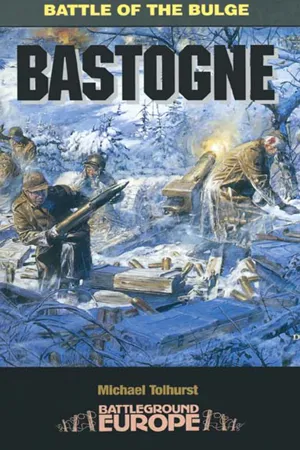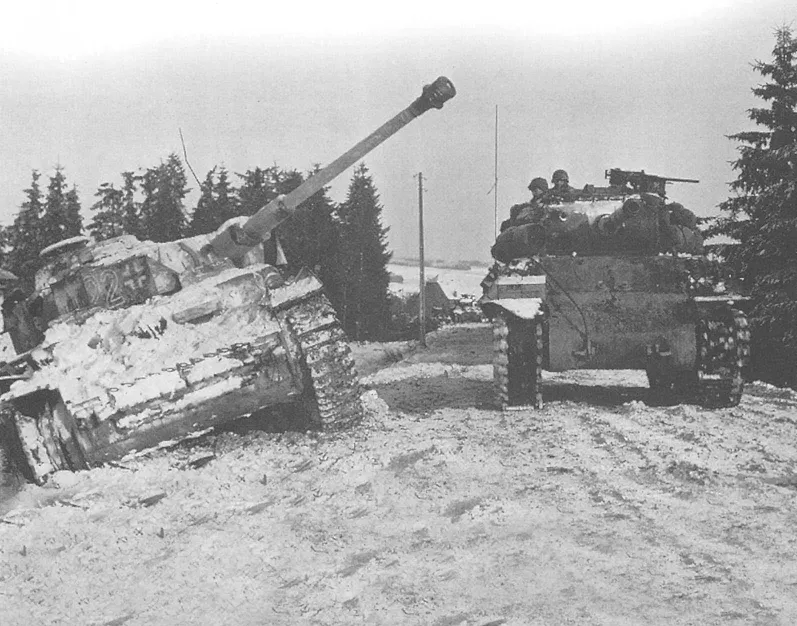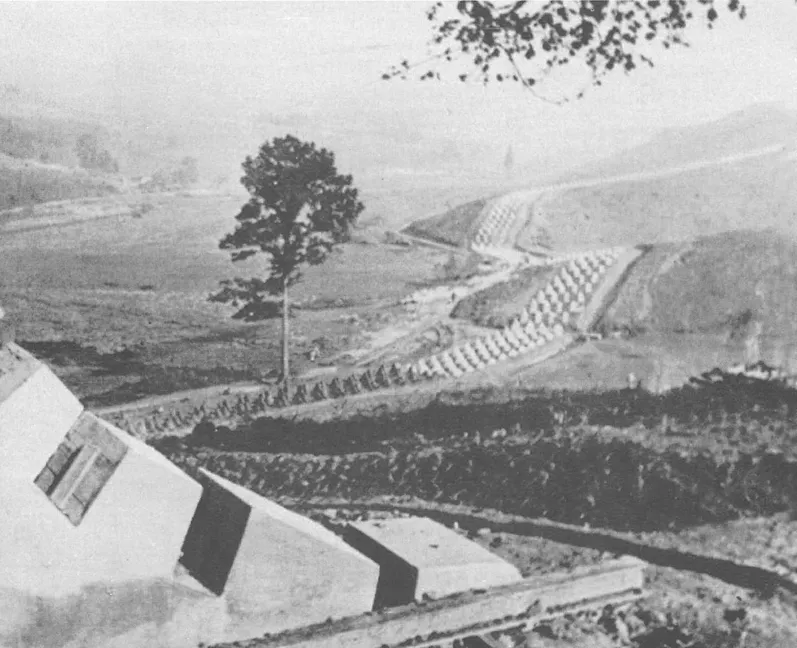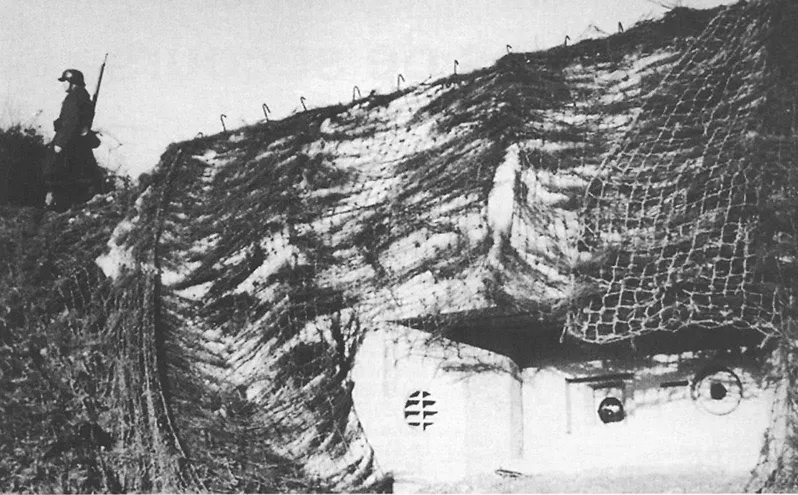
- 160 pages
- English
- ePUB (mobile friendly)
- Available on iOS & Android
eBook - ePub
About this book
By Christmas 1944, the Allies were on the threshold of victory, having remorselessly rolled the Germans back to the very borders of "The Fatherland". The, the shock of a massive Nazi counter-attack through the Ardennes in the depth of winter threw the Allies into confusion. Bastogne was at the very centre of this dramatic and most dangerous setback.
Frequently asked questions
Yes, you can cancel anytime from the Subscription tab in your account settings on the Perlego website. Your subscription will stay active until the end of your current billing period. Learn how to cancel your subscription.
At the moment all of our mobile-responsive ePub books are available to download via the app. Most of our PDFs are also available to download and we're working on making the final remaining ones downloadable now. Learn more here.
Perlego offers two plans: Essential and Complete
- Essential is ideal for learners and professionals who enjoy exploring a wide range of subjects. Access the Essential Library with 800,000+ trusted titles and best-sellers across business, personal growth, and the humanities. Includes unlimited reading time and Standard Read Aloud voice.
- Complete: Perfect for advanced learners and researchers needing full, unrestricted access. Unlock 1.4M+ books across hundreds of subjects, including academic and specialized titles. The Complete Plan also includes advanced features like Premium Read Aloud and Research Assistant.
We are an online textbook subscription service, where you can get access to an entire online library for less than the price of a single book per month. With over 1 million books across 1000+ topics, we’ve got you covered! Learn more here.
Look out for the read-aloud symbol on your next book to see if you can listen to it. The read-aloud tool reads text aloud for you, highlighting the text as it is being read. You can pause it, speed it up and slow it down. Learn more here.
Yes! You can use the Perlego app on both iOS or Android devices to read anytime, anywhere — even offline. Perfect for commutes or when you’re on the go.
Please note we cannot support devices running on iOS 13 and Android 7 or earlier. Learn more about using the app.
Please note we cannot support devices running on iOS 13 and Android 7 or earlier. Learn more about using the app.
Yes, you can access Bastogne by Michael Tolhurst in PDF and/or ePUB format, as well as other popular books in History & Military & Maritime History. We have over one million books available in our catalogue for you to explore.
Information
CONTENTS
Introduction
Acknowledgments
Chapter 1: HITLER’S PLAN
Chapter 2: ATTACK
Chapter 3: BREAKTHROUGH
Chapter 4: ENCIRCLEMENT
Chapter 5: RELIEF OF BASTOGNE
Chapter 6: END OF THE BULGE
Chapter 7: THE GUIDE
INDEX

INTRODUCTION
It is hoped, with the aid of this book, that the reader will be helped to understand how the siege and relief of Bastogne in the cold December of 1944 came about. The Battle of the Ardennes, or as it came to be known, ‘The Battle of the Bulge’ (a term given by its characteristic shape formed by the German thrust through the Allied lines), was to become one of the greatest battles fought by the US Army in Europe. This, the last all out offensive initiative of the Second World War by the Germans, although brilliantly planned and executed, was to prove to be the beginning of the end for them in the West.
During the German drive west there were many actions fought in the Ardennes region, this book is about one of them.
This part of Europe is one of the most picturesque areas imaginable. High ridges and deep ravines abound in the area criss-crossed by fast flowing rivers and streams. Everywhere is covered with trees, many of them conifers. Main roads are few and far between and generally follow the paths of the rivers through the valleys. On the Belgium-Luxembourg-German border the terrain is high and craggy. A volcanic ridge runs north to south just inside the German border and forms part of what the Germans call the Eifel Region. Winding itself through this is the River Our, which helps to make a natural barrier on Germany’s frontier. This terrain stretches from Monschau in the north down to the River Moselle in the south. As if this was not a formidable barrier in itself, the Germans had constructed a line of defences along its borders from Holland down to the Swiss frontier. More than 3,000 concrete bunkers with interlocking fields of fire were built, along with anti-tank obstacles or dragons’ teeth, forming a barrier across the open ground. The German propaganda machine proudly labelled the defences as the ‘West Wall’, however, the Allies referred to it as the – Siegfried Line.

The German frontier with Belgium showing the dragons teeth defences intended to stop tanks.

Concrete casemates provided strongpoints along the German West Wall. This one is draped with camouflage netting to conceal it from Allied aircraft.
Long before the war the Ardennes was a popular tourist area and people would visit to take in the breathtaking scenery, fill their lungs with the fresh air and of course sample the fine cuisine on offer. The same can be said for the Ardennes today, but now it has the added interest of being a battlefield that has changed little since the opposing armies slogged it out in that bitter winter during the last few months of the Second World War.

Bastogne is, and was in 1944, a market town in southern Belgium standing behind the high ridges of the Eifel on a plateau surrounded by rolling hills. Much of the area is pasture land with interspersed woods made up mostly of conifers. Since the 15th Century the town has been famous for its smoked hams.
Looking at a map it is not difficult to see just how strategic the towns of Bastogne and St Vith were within the Ardennes region. They both held the key for the local road and rail network.
In the late Summer of 1944 the Allied armies had pursued retreating German formations through France, Belgium and Luxembourg and were poised to enter Germany. The next major task was to break through the West Wall and cross the River Rhine, a much respected natural obstacle. Supplies for the rapidly advancing armies were still being landed over the beaches of Normandy and ferried by vast convoys of trucks to the front lines hundreds of miles away. (These convoys were actually using more petrol than was being delivered). Although some seaports had been captured, the Germans had demolished most of the facilities before withdrawing. The port of Antwerp was the exception. It had been captured so quickly by the British in the beginning of September that the German defenders had had no time to set their demolition charges off. But the port was still closed to shipping, because the Germans controlled the Schelde Estuary, the entrance to Antwerp, from the Walcheren Islands. This was not opened for Allied shipping until the end of November.
With winter upon them, and with a lack of vital equipment, the Allies were slowing down. It was decided to halt and straighten the line, allowing the much needed supplies to catch up, and the weather to become more favourable in the spring of 1945 before beginning another offensive.
In and along the West Wall (breached in some places) the Allied troops dug in and made themselves as comfortable as possible. The Ardennes was one such area. The American First Army in this region had experienced bitter fighting around the border town of Aachen and had captured it in October. South of Aachen, in a heavily wooded area known as the Hurtgen Forest, division after division of American troops had been decimated. These weakened units, along with fresh divisions arriving from the United States, were sent to the Ardennes region. The battered formations to rest and take in replacements and the green divisions to become accustomed to front-line life. It became known as a ‘Ghost Front’, nothing much happened as both sides sent out patrols and went on to report back that all was quiet.

Fighting in the Hurtgen Forest was intense, the Germans putting up fierce resistance at this point on the border of the Third Reich.
General Middleton’s VIII Corps, of the 1st Army, occupied the area from just north of Losheim, right down south to the Luxembourg-French border. Along this line defending were, from north to south: the 14th Cavalry Group, 106th Infantry Division, 28th Infantry Division, a Combat Command from the 9th Armored Division and the 4th Infantry Division. These green or under-strength battle weary divisions were holding a line of about eighty-five miles – thus being grossly overstretched. Although the hilly terrain favoured the defender, they were hard pressed to adequately cover it.
As already stated, the two principal towns in the area were St Vith and Bastogne both being major hubs for the road and rail systems and both had railway stations. It was recognized that whoever had control of the two towns also had control of the road and rail network throughout the entire region.
Lieutenant General Hasso von Manteuffel, commander of the Fifth Panzer Army, along with two other armies, were massing undetected in and behind the dense Eifel region. He was well aware of the importance of the two towns and capture of St Vith and Bastogne featured on his list of objectives for the coming offensive.
The scene was set for one of the biggest battles of the Second World War. A battle of apparent surprise to the Allies and one that would finally be the undoing of Nazi Germany by expending virtually all of its reserves.
To say it was a complete surprise to the Allies would be wrong, prisoners had been taken by American patrols, these Germans had willingly told of a coming offensive. Certain telltale signs were there that the Germans were, even at this late stage in the conflict, considering going...
Table of contents
- Cover
- Half Title
- Series
- Title Page
- Copyright
- Contents